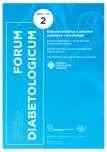Immune metabolic view on insulin resistance
Authors:
Marián Mokáň; Peter Galajda
Authors‘ workplace:
I. interná klinika JLF UK a UNM, Martin
Published in:
Forum Diab 2021; 10(2): 136-141
Category:
Overview
Insulin resistance is defined as insufficient insulin metabolic effect in target tissues, including glucose utilisation in skeletal muscle, suppression of hepatic glucose production and suppression of lipolysis in fat tissue. Insulin resistance is one of central etiopathogenetic mechanisms of prediabetic states, including impaired fasting glucose and impaired glucose tolerance, metabolic syndrome and type 2 diabetes mellitus. Etiopathogenesis of insulin resistance in obesity implements expansion of dysfunctional adipose tissue with activation of immune system, induction of low grade inflammatory reaction and induction of insulin resistance by cytokine and lipids. Insulin resistance has primary adaptive importance in acute defense reaction against microorganism. Inflammatory induced insulin resistance in metabolic tissues is necessary for relocation of glucose to rapid proliferated immune cells utilized aerobic glycolysis such main energetic mechanism. Long-acting effect of insulin resistance due to expansion of adipose tissue in obesity is associated with metabolic syndrome, type 2 diabetes mellitus and cardiovascular diseases.
Keywords:
insulin resistance – low grade inflammatory reaction – inflammatory dysfunction of adipose tissue – inflammatory cytokines – saturated fatty acids
Sources
1. Galajda P, Mokáň M. Metabolický syndróm, diabetes mellitus a pridružené ochorenia. Vydavateľstvo QuickPrint: Martin 2020. ISBN 978– 80–969713–9-8.
2. Keller SR, Lienhard GE. Insulin signalling: the role of insulin receptor substrate 1. Trends in Cell Biology 1994; 4(4): 115–119. Dostupné z DOI: <http://doi: 10.1016/0962–8924(94)90065–5>.
3. Holman GD, Kasuga M. From receptor to transporters: insulin signalling to glucose transport. Diabetologia 1997; 40(9): 991–1003. Dostupné z DOI: <http://doi: 10.1007/s001250050780>.
4. Kahn BB, Shepard PR. Glucose transporters and insulin action. N Engl J Med 1999; 341(4): 248–257. Dostupné z DOI: <http://doi:10.1056/NEJM199907223410406>.
5. Marchand-Brustel Y. Molecular mechanism of insulin action in normal and insulin – resistant states. Exp Clin Endocrinol Diabetes 1999; 107(2): 126–132. Dostupné z DOI: <http://doi: 10.1055/s-0029–1212087>.
6. Petersen MC, Shulman GI. Mechanism of insulin action and insulin resistance. Physiol Rev 2018; 98(4): 2133–2223. Dostupné z DOI: <http://doi: 10.1152/physrev.00063.2017>.
7. Mokáň M, Galajda P. Primárna a sekundárna inzulínová rezistencia. Vnitřní lék 2019; 65(4): 264–272.
8. Galajda P, Prídavková D, Mokáň M, Michalová R jr, Mokáň M. Metabolický syndróm, prediabetické stavy a prevencia diabetes mellitus 2. typu. Ateroskleróza 2018; 22: 1143–1148.
9. Laclaustra M, Corella D, Ordovas JM. Metabolic syndrome pathophysiology: The role of adipose tissue. Nutr Metab Cardiovasc Dis 2007; 17(2): 125–139. Dostupné z DOI: <http://doi: 10.1016/j.numecd.2006.10.005>.
10. Boden G. Role of fatty acids in the pathogenesis of insulin resistance and NIDDM. Diabetes 1996; 46(1): 3–10.
11. Howard BV. Insulin resistance and lipid metabolism. Am J Cardiol 1999; 84(1A): 28J-32J. Dostupné z DOI: <http://doi: 10.1016/s0002–9149(99)00355–0>.
12. Lewis GF, Carpentier A, Adeli K et al. Disordered fat storage and mobilisation in the pathogenesis of insulin resistance and type 2 diabetes. Endocrine Review 2002; 23(2): 201–229. Dostupné z DOI: <http://doi: 10.1210/edrv.23.2.0461>.
13. Rocha DM, Caldas AP, Oliveira LL et al. Saturated fatty acids trigger TLR4-mediated inflammatory response. Atherosclerosis 2016; 244: 211–215. Dostupné z DOI: <http://doi: 10.1016/j.atherosclerosis.2015.11.015>.
14. Cani PD, Amar J, Iglesias MA et al. Metabolic endotoxemia initiates obesity and insulin resistance. Diabetes 2007; 56(7): 1761–1772. Dostupné z DOI: <http://doi: 10.2337/db06–1491>.
15. Jialal I, Rajamani U. Endotoxemia of metabolic syndrome: a pivotal mediator of meta-inflammation. Metab Syndr Relat Disord 2014; 12(9): 454–456. Dostupné z DOI: <http://doi: 10.1089/met.2014.1504>.
16. Eheim A, Medrikova D, Herzig S. Immune cells and metabolic dysfunction. Semin Immunopathol 2014; 36(1): 13–25. Dostupné z DOI: <http://doi: 10.1007/s00281–013–0403–7>.
17. Lackey DE, Olefsky JM. Regulation of metabolism by innate immune system. Nat Rev Endocrinol 2016; 12(1): 15–28. Dostupné z DOI: <http://doi: 10.1038/nrendo.2015.189>.
18. Czech MP. Mechanisms of insulin resistance related to white, beige, and brown adipocytes. Molecular Metab 2020; 34: 27–42. Dostupné z DOI: <http://doi: 10.1016/j.molmet.2019.12.014>.
19. Fernandez-Real JM, Ricart W. Insulin resistance and inflammation in an evolutionary perspectives: the contribution of cytokine genotype/ phenotype to thriftiness. Diabetologia 1999; 42(11): 1367–1374. Dostupné z DOI: <http://doi: 10.1007/s001250051451>.
20. Hotamisligil GS. Inflammation, metaflammation and immunometabolic disorders. Nature 2017; 542(7640): 177–185. Dostupné z DOI: <http://doi: 10.1038/nature21363>.
21. Pinheiro-Machado E, Gurgul-Convey E, Marzec MT. Immunometabolism in type 2 diabetes mellitus: tissue-specific interactions. Archi Med Sci 2020; Dostupné z DOI: <http://doi.org/10.5114/aoms.2020.92674>.
22. Pruimboom L, Raison CL, Muskiet FAJ. The selfish immune system when the immune system overrides the ‘selfish’ brain. J Immunol Clin Microbiol 2020; 5(1): 1–34. Dostupné z WWW: <https://dergipark.org.tr/en/download/article-file/936333>.
Labels
Diabetology Endocrinology Internal medicineArticle was published in
Forum Diabetologicum

Most read in this issue
- Left ventricular hypertrophy in patients with diabetes mellitus: what we don‘t think about?
- Catheter ablation of atrial fibrillation in patients with diabetes mellitus
- Alternative ways of insulin application
- Cardioprotective effect of treatment by GLP-1 analogues in the view of results of newest clinical studies
